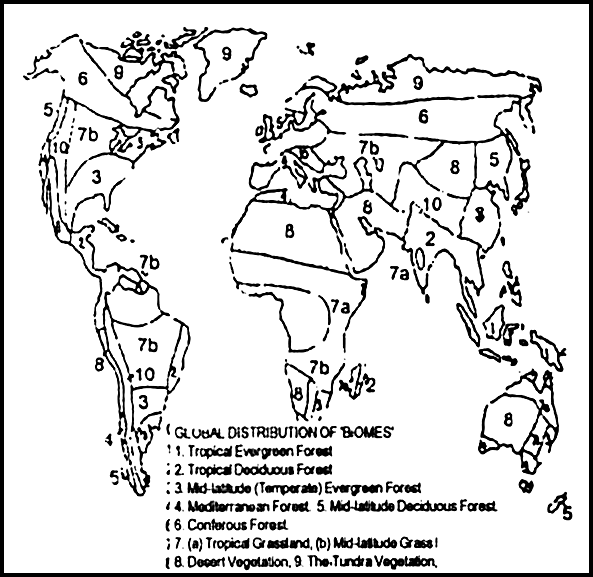Forests, grasslands, thorny shrubs and tundra are major plant biomes.
Forest Types : Forests are classified into two types :
(1) Evergreen and
(2) Deciduous Forests.
1. Evergreen Forests : These forests remain green throughout the year, as there is no mass shedding of leaves throughout the year. Evergreen forests are of the following types :
(i) Tropical Evergreen Forests : These occur in equatorial regions and tropical coastal regions having heavy rainfall. There is a luxuriant growth and variety of vegetation. Trees have broad leaves. Mahogany, ebony and rosewood are of commercial value among tropical evergreen trees.
(ii) Mid-latitude Evergreen Forests : These forests occur in western margins of continents in middle latitudes. Here rainfall is received in winter and the summer is dry. Plant have spiny, waxy or small leaves to reduce transpiration. Trees are widely spaced and shrubs occur in between. Cork, oak, olive and Chestnut are the examples.
(iii) Coniferous Forests: They are found around the north polar region, Europe, Asia and North America. Trees are tall and conical in shape. They have thick needle-shaped leaves to reduce transpiration and to protect them from cold winter.
2. Deciduous Forests : Trees shed their leases in a particular season to conserve loss of moisture. Deciduous forests are of the following types :
(i) Tropical Deciduous Forests : These are found in subtropical regions with a distinct dry season. These forests have fewer species and are less dense. Teak is a valuable hardwood tree found in these forests. These are found in monsoon regions of Asia, central America, Brazil and northern Asia.
(ii) Mid-latitude Deciduous Forests : These occur in coastal regions of cool climates. Trees shed their leaves in winter when temperature is below 6°C. These occur in the region of western Europe, north-eastern China, Japan, north-eastern United States etc.
3. Grasslands: Grasses are shallow rooted plants which thrive under varying climatic conditions. They are divided into tropical grasslands and mid-latitude grasslands.
(i) Tropical Grasslands : These occur in the interiors of continents in the tropical zone. These grasses are tall, about 2 metres in height. These are found in equatorial regions of Africa, Brazilian Plateau, Deccan Plateau etc.
(ii) Mid-latitude Grasslands : These occur in the interiors of continents in mid-latitudes receiving moderate rainfall. These grasses are short and trees are absent. These are found in regions of Russia, U.S.A., Canada and South African plateau.
4. Desert Vegetation : This vegetation occurs in regions of low rainfall. Short shrubs occur in patches. Cacti, thorny bushes and coarse grasses are found in deserts.
5. Tundra Vegetation : This type of vegetation occurs around the North Pole in Eurasia and North America. Patches of mosses, lichens, wild-flowering shrubs are seen. The land is snow-covered during the long winters.

World Biomes






